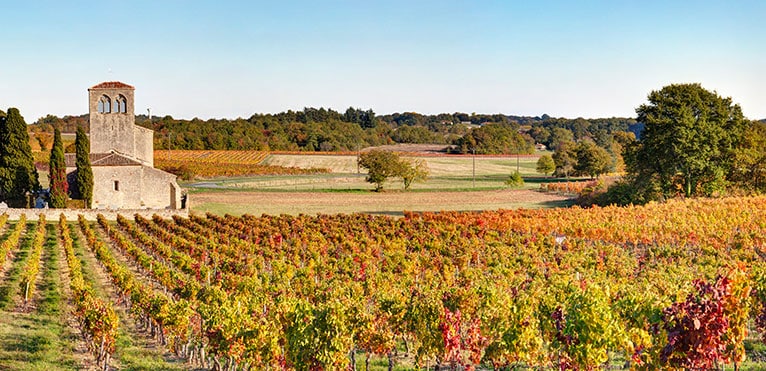
Contents
The Côtes-de-Bergerac appellation is a wine from southwestern France, produced in the southern Dordogne. Côtes-de-Bergerac has been classified AOC [passage supprimé] since 1955.. The appellation covers more than 90 communes, producing mainly sweet, semi-dry and mellow white wines, but also red wines.
The Côtes-de-Bergerac appellation is linked to international history
In the XIIIth century, Bergerac was a major trading center with protectionist laws on Bergerac wines. After the Hundred Years’ War town de Bergerac takes over the vineyards of the southern Dordogne. In the 16th centuryth century century, the flight of Huguenots to the Netherlands following the revocation of the Edict of Nantes in 1685 gave rise to a trade between Dutch merchants and Bergerac winegrowers.
Côtes-de-Bergerac finally obtained its specific protected designation of origin in 1955, in the heart of the Bergerac AOC geographical production area. Since then, winegrowers based in the 90 designated communes have had to comply with a precise charter before they can use the name “Côtes-de-Bergerac” on their bottles. In particular, the vines must have a planting density of at least 4000 plants / hectares, a yield limited to 55 hectoliters / hectares in white and 50 in red. White wines must be at least 50% Muscadelle, Sauvignon, Sauvignon Gris and Sémillon. The red wines are blends, with the main grape varieties being Cabernet Sauvignon, Cabernet Franc, Merlot and Malbec. The alcoholic strength of sweet white wines must be at least 12%, while that of red wines must be between 11 and 13%.
A vineyard in the heart of Bergerac
The vineyard extends over the same area as the Bergerac appellation. With a potential planting area of 13,000 hectares and vineyards dedicated to Côtes-De-Bergerac planted over 1,500 hectares, the appellation’s soils contain a variety of elements. Production is based on a rigorous selection of the best plantations. This results in wines with better ageing potential, richer and fuller-bodied.
The terroir crosses the Dordogne from east to west through a hilly landscape. There are different terroirs depending on geographical location. To the west, these are mostly south-facing slopes with optimum exposure to the sun, and are composed of marine limestone. In the south-west, boulbènes are predominant, and in the south-east, lacustrine limestone. To the north, the vines are planted on hilltops, where the soil is composed of sand and gravelly clay. Finally, on the terraces of the Dordogne valley, we find gravel.
The region’s climate is temperate oceanic, with rainfall well distributed over the growing season. There’s plenty of sunshine from May to August. The summers are hot and dry, guaranteeing good ripening of the grapes. From November to December, rainfall supplies the soil with water.
Recognizing a Côtes-de-Bergerac
Côtes-de-Bergerac blanc is a sweet wine made mainly from Muscadelle, Sauvignon, Sauvignon Gris and Sémillon grapes. This wine has a pale yellow color that can turn golden if the grapes used have been affected by “noble rot” due to botrytis cinerea. The bouquet is aromatic, with hints of honey, roasted notes and even wax if the sweetness is high. Silky texture on the palate. The wine is structured and offers a delicate marriage of roundness and freshness. Such a wine will keep for an average of 10 years.
Red Côtes-de-Bergerac is intense, dark and deep, with purplish highlights. It offers a complex nose, similar to Bordeaux wines because the grape varieties used are similar. Primary aromas of black and red fruits, followed by notes of undergrowth. Finally, tertiary notes offer aromas such as cocoa beans, coffee, caramel and spices. On the palate, its density makes itself felt, it is robust. A young wine with firm tannins, it is a wine for laying down par excellence, with an ageing potential of 8 years.
How to match a Côtes-de-Bergerac?
A Côtes-de-Bergerac connoisseur will know how to match each bottle with a specific dish. For sweet white wines, serve at a temperature of 10° to ensure perfect freshness for tasting. Of course, this wine goes well with foie gras, but it can also be enjoyed as an aperitif, with desserts or with blue-veined cheeses. A red Côtes-de-Bergerac is an excellent accompaniment to grilled meats or roast poultry. Gourmets pair it with grilled prime rib with porcini mushrooms and truffle shavings. To allow oxygenation to take place, it can be decanted for two hours at a temperature of 16° before drinking.
The best vintages of Côtes-de-Bergerac
One vintage differs from another according to the year’s exceptional or less-than-exceptional weather conditions. In the sweet white category, 1988, 1990 and 2005 stand out as exceptional vintages. We should also mention 1983, 1985 and 1989, which are classified as excellent vintages. As for red wine production, like many wines in the south-west, 2005 was the vintage of the century. In 2000, conditions were also ripe for the production of an exceptional vintage. Finally, we must mention 1989, 1990, 1995 and 1998, which, thanks to remarkable weather conditions, were classified as great vintages.
Some outstanding Côtes-de-Bergerac producers
Château Grande Maison
Château Grande Maison produces the Côtes-de-Bergerac, Bergerac and Monbazillac appellations. Straddling all three appellations, the estate overlooks the banks of the Dordogne. The entire production is now organic, and a pond in the heart of the 14 hectares of vines allows the fungus responsible for “noble rot”, Botrytis, to develop on the vines that produce the sweet white wines.
Domaine Haut Montlong
Since 1925, this family-run winery in the Côtes de Bergerac has been showcasing the wines and winegrowing heritage of the Bergerac region. Converted to 100% organic farming, the 45 hectares of vines produce red and sweet white Côtes-de-Bergerac every year. The work of these independent winegrowers was rewarded in particular by in Paris in 2018 winning the gold medal at the concours agricole for the 2015 vintage “Les Vents D’Anges” in red Côtes-de-Bergerac.